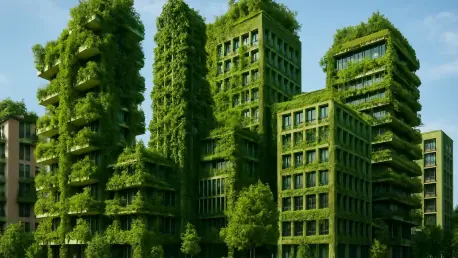As urban populations swell and temperatures climb due to intensifying heatwaves across Europe, cities are grappling with the urgent challenge of staying cool while maintaining livability. The urban heat island effect, where concrete and metal absorb and radiate heat, exacerbates this issue, turning densely populated areas into sweltering zones. In response, innovative projects in regions like Spain’s Catalonia and Italy’s Adriatic coast are pioneering a powerful solution: integrating greenery into existing buildings. These efforts aim to lower temperatures, enhance biodiversity, and improve quality of life without the need for expansive new parklands. By transforming rooftops and walls into living ecosystems, urban centers are not only addressing climate challenges but also redefining how residents connect with nature in constrained spaces. This approach marks a significant shift in city planning, prioritizing sustainability and community well-being amidst rising environmental pressures.
Innovative Greening Projects in Europe
In Spain’s Catalonia region, a groundbreaking initiative known as BIG4LIFE is leading the charge to cool cities like Barcelona and El Prat de Llobregat through building-integrated greenery. This project focuses on retrofitting existing structures with rooftop gardens and vertical plant walls, utilizing sustainable techniques such as xeriscaping. Xeriscaping employs drought-tolerant plants and water-efficient landscaping, perfectly suited to the harsh Mediterranean climate where water scarcity is a persistent concern. Beyond temperature reduction, the initiative fosters biodiversity by creating habitats for local flora and fauna within urban settings. Community involvement plays a critical role, ensuring that these green spaces are maintained over the long term through resident participation and education. The result is a dual benefit: cooler environments and a renewed sense of ownership among locals who actively contribute to their city’s transformation into a more resilient and vibrant space.
Meanwhile, along Italy’s Adriatic coast, the Life+ A_GreeNet project is tackling similar challenges with a comprehensive approach to urban greening. This initiative combines green walls, urban forests, and water features to target a significant temperature drop of 4–10°C by 2030. Inspired by the devastating heatwaves that have struck the region in recent years, the project prioritizes densely populated areas where asphalt and concrete dominate the landscape. By integrating natural elements into building designs, it not only mitigates heat but also enhances air quality and provides communal spaces for social interaction. The emphasis on diverse greenery, from low-maintenance plants to expansive tree canopies, showcases a tailored response to local conditions. Supported by broader European frameworks like the EU Covenant of Mayors’ Cities Refresh campaign, this effort reflects a growing recognition that nature-based solutions are essential for sustainable urban futures across the continent.
Redefining Urban Spaces for Climate Adaptation
The shift from traditional urban planning to reimagining existing infrastructure as living ecosystems represents a profound change in how cities address space constraints. Historically, creating new parks required vast tracts of land, a luxury many dense urban areas simply cannot afford. Instead, projects like those in Spain and Italy repurpose rooftops and facades, turning them into shared green spaces that serve as both cooling mechanisms and community hubs. These areas not only lower ambient temperatures but also offer residents places to gather, relax, and reconnect with nature amidst the concrete jungle. Data from Italy’s Climate and Health Observatory underscores the urgency of such adaptations, highlighting how reducing asphalt and increasing vegetation can significantly improve public health outcomes. This innovative approach demonstrates that even the most crowded cities can integrate nature effectively, balancing environmental needs with human well-being.
Another key aspect of this transformation is the scalability and adaptability of green building solutions to diverse urban challenges. In Catalonia, the use of hardy plants like sedum ensures low maintenance while still delivering cooling benefits, ideal for regions with limited resources for upkeep. Conversely, Italy’s urban forests provide a more intensive greening strategy, creating microclimates that combat heat on a larger scale. Both methods align with the New European Bauhaus initiative, which champions sustainable and inclusive design as a cornerstone of future cityscapes. The flexibility of these projects allows municipalities to tailor solutions to their specific climatic and social contexts, ensuring broader applicability across Europe. As urban heat continues to pose a threat, these initiatives offer a blueprint for other regions to follow, proving that integrating nature into built environments can yield lasting environmental and societal gains.
Building a Cooler Legacy
Reflecting on the strides made by projects like BIG4LIFE and Life+ A_GreeNet, it’s evident that a powerful movement has taken root in European urban development. These initiatives showcase how reintroducing nature into cityscapes through creative building designs effectively counters the challenges of rising temperatures. They pave the way for cooler, healthier environments while fostering vibrant communities that embrace sustainability. Looking ahead, the focus should shift to expanding these models globally, adapting them to varied climates and urban densities. Policymakers and planners must prioritize funding and incentives for green infrastructure, ensuring that such transformations become standard practice rather than exceptions. Collaboration between governments, architects, and residents will be crucial to sustain momentum, turning every building into a potential oasis. By building on past successes, cities worldwide can craft a future where heat is no longer a barrier to livability, but a challenge met with innovative, nature-driven solutions.









